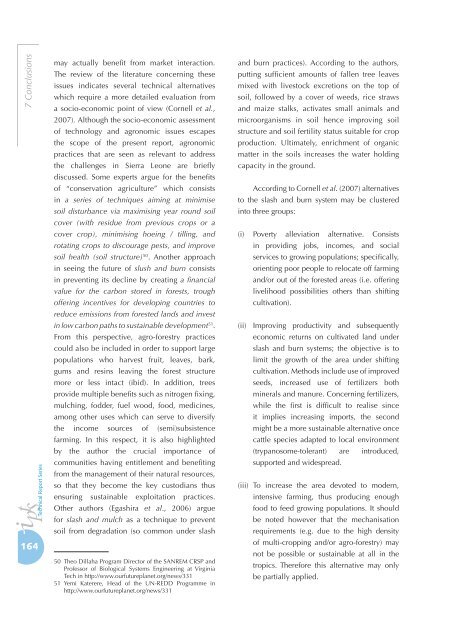SIERRA LEONE maq 4ª.indd - agrilife - Europa
SIERRA LEONE maq 4ª.indd - agrilife - Europa
SIERRA LEONE maq 4ª.indd - agrilife - Europa
You also want an ePaper? Increase the reach of your titles
YUMPU automatically turns print PDFs into web optimized ePapers that Google loves.
7 Conclusions<br />
164<br />
may actually benefit from market interaction.<br />
The review of the literature concerning these<br />
issues indicates several technical alternatives<br />
which require a more detailed evaluation from<br />
a socio-economic point of view (Cornell et al.,<br />
2007). Although the socio-economic assessment<br />
of technology and agronomic issues escapes<br />
the scope of the present report, agronomic<br />
practices that are seen as relevant to address<br />
the challenges in Sierra Leone are briefly<br />
discussed. Some experts argue for the benefits<br />
of “conservation agriculture” which consists<br />
in a series of techniques aiming at minimise<br />
soil disturbance via maximising year round soil<br />
cover (with residue from previous crops or a<br />
cover crop), minimising hoeing / tilling, and<br />
rotating crops to discourage pests, and improve<br />
soil health (soil structure) 50 . Another approach<br />
in seeing the future of slush and burn consists<br />
in preventing its decline by creating a financial<br />
value for the carbon stored in forests, trough<br />
offering incentives for developing countries to<br />
reduce emissions from forested lands and invest<br />
in low carbon paths to sustainable development51 .<br />
From this perspective, agro-forestry practices<br />
could also be included in order to support large<br />
populations who harvest fruit, leaves, bark,<br />
gums and resins leaving the forest structure<br />
more or less intact (ibid). In addition, trees<br />
provide multiple benefits such as nitrogen fixing,<br />
mulching, fodder, fuel wood, food, medicines,<br />
among other uses which can serve to diversify<br />
the income sources of (semi)subsistence<br />
farming. In this respect, it is also highlighted<br />
by the author the crucial importance of<br />
communities having entitlement and benefiting<br />
from the management of their natural resources,<br />
so that they become the key custodians thus<br />
ensuring sustainable exploitation practices.<br />
Other authors (Egashira et al., 2006) argue<br />
for slash and mulch as a technique to prevent<br />
soil from degradation (so common under slash<br />
50 Theo Dillaha Program Director of the SANREM CRSP and<br />
Professor of Biological Systems Engineering at Virginia<br />
Tech in http://www.ourfutureplanet.org/news/331<br />
51 Yemi Katerere, Head of the UN-REDD Programme in<br />
http://www.ourfutureplanet.org/news/331<br />
and burn practices). According to the authors,<br />
putting sufficient amounts of fallen tree leaves<br />
mixed with livestock excretions on the top of<br />
soil, followed by a cover of weeds, rice straws<br />
and maize stalks, activates small animals and<br />
microorganisms in soil hence improving soil<br />
structure and soil fertility status suitable for crop<br />
production. Ultimately, enrichment of organic<br />
matter in the soils increases the water holding<br />
capacity in the ground.<br />
According to Cornell et al. (2007) alternatives<br />
to the slash and burn system may be clustered<br />
into three groups:<br />
(i) Poverty alleviation alternative. Consists<br />
in providing jobs, incomes, and social<br />
services to growing populations; specifically,<br />
orienting poor people to relocate off farming<br />
and/or out of the forested areas (i.e. offering<br />
livelihood possibilities others than shifting<br />
cultivation).<br />
(ii) Improving productivity and subsequently<br />
economic returns on cultivated land under<br />
slash and burn systems; the objective is to<br />
limit the growth of the area under shifting<br />
cultivation. Methods include use of improved<br />
seeds, increased use of fertilizers both<br />
minerals and manure. Concerning fertilizers,<br />
while the first is difficult to realise since<br />
it implies increasing imports, the second<br />
might be a more sustainable alternative once<br />
cattle species adapted to local environment<br />
(trypanosome-tolerant) are introduced,<br />
supported and widespread.<br />
(iii) To increase the area devoted to modern,<br />
intensive farming, thus producing enough<br />
food to feed growing populations. It should<br />
be noted however that the mechanisation<br />
requirements (e.g. due to the high density<br />
of multi-cropping and/or agro-forestry) may<br />
not be possible or sustainable at all in the<br />
tropics. Therefore this alternative may only<br />
be partially applied.
















